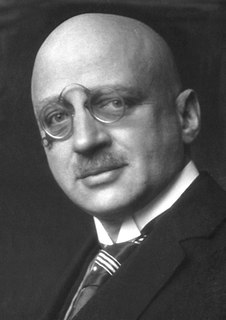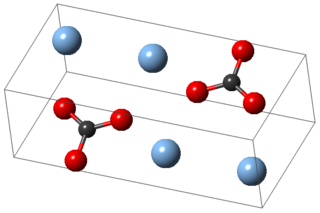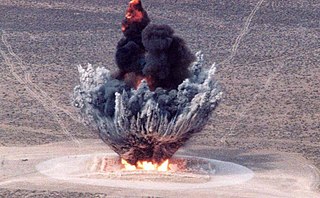
An explosive is a reactive substance that contains a great amount of potential energy that can produce an explosion if released suddenly, usually accompanied by the production of light, heat, sound, and pressure. An explosive charge is a measured quantity of explosive material, which may be composed of a single ingredient or a combination of two or more.

The Haber process, also called the Haber–Bosch process, is an artificial nitrogen fixation process and is the main industrial procedure for the production of ammonia today. It is named after its inventors, the German chemists Fritz Haber and Carl Bosch, who developed it in the first decade of the 20th century. The process converts atmospheric nitrogen (N2) to ammonia (NH3) by a reaction with hydrogen (H2) using a metal catalyst under high temperatures and pressures:

Nitroglycerin (NG), also known as nitroglycerine, trinitroglycerin (TNG), nitro, glyceryl trinitrate (GTN), or 1,2,3-trinitroxypropane, is a dense, colorless, oily, explosive liquid most commonly produced by nitrating glycerol with white fuming nitric acid under conditions appropriate to the formation of the nitric acid ester. Chemically, the substance is an organic nitrate compound rather than a nitro compound, yet the traditional name is often retained. Invented in 1847, nitroglycerin has been used as an active ingredient in the manufacture of explosives, mostly dynamite, and as such it is employed in the construction, demolition, and mining industries. Since the 1880s, it has been used by the military as an active ingredient, and a gelatinizer for nitrocellulose, in some solid propellants, such as cordite and ballistite.

Trinitrotoluene (; TNT), or more specifically 2-methyl-1,3,5-trinitrobenzene, is a chemical compound with the formula C6H2(NO2)3CH3. This yellow solid is sometimes used as a reagent in chemical synthesis, but it is best known as an explosive material with convenient handling properties. The explosive yield of TNT is considered to be the standard measure of bombs and the power of explosives. In chemistry, TNT is used to generate charge transfer salts.

Urea, also known as carbamide, is an organic compound with chemical formula CO(NH2)2. This amide has two –NH2 groups joined by a carbonyl (C=O) functional group.

A warhead is the explosive or toxic material that is delivered by a missile, rocket, or torpedo. It is a type of bomb.

Ammonium nitrate is a chemical compound, the nitrate salt of the ammonium cation. It has the chemical formula NH4NO3, simplified to N2H4O3. It is a white crystal solid and is highly soluble in water. It is predominantly used in agriculture as a high-nitrogen fertilizer. Its other major use is as a component of explosive mixtures used in mining, quarrying, and civil construction. It is the major constituent of ANFO, a popular industrial explosive which accounts for 80% of explosives used in North America; similar formulations have been used in improvised explosive devices. Many countries are phasing out its use in consumer applications due to concerns over its potential for misuse.

In chemistry, an oxidizing agent is a substance that has the ability to oxidize other substances — in other words to cause them to lose electrons. Common oxidizing agents are oxygen, hydrogen peroxide and the halogens.
In organic chemistry, transesterification is the process of exchanging the organic group R″ of an ester with the organic group R′ of an alcohol. These reactions are often catalyzed by the addition of an acid or base catalyst. The reaction can also be accomplished with the help of enzymes (biocatalysts) particularly lipases (E.C.3.1.1.3).
Nitromethane is an organic compound with the chemical formula CH
3NO
2. It is the simplest organic nitro compound. It is a polar liquid commonly used as a solvent in a variety of industrial applications such as in extractions, as a reaction medium, and as a cleaning solvent. As an intermediate in organic synthesis, it is used widely in the manufacture of pharmaceuticals, pesticides, explosives, fibers, and coatings. Nitromethane is used as a fuel additive in various motorsports and hobbies, e.g. Top Fuel drag racing and miniature internal combustion engines in radio control, control line and free flight model aircraft.

Detonation is a type of combustion involving a supersonic exothermic front accelerating through a medium that eventually drives a shock front propagating directly in front of it. Detonations occur in both conventional solid and liquid explosives, as well as in reactive gases. The velocity of detonation in solid and liquid explosives is much higher than that in gaseous ones, which allows the wave system to be observed with greater detail.
The vast majority of explosives are chemical explosives. Explosives usually have less potential energy than fuels, but their high rate of energy release produces a great blast pressure. TNT has a detonation velocity of 6,940 m/s compared to 1,680 m/s for the detonation of a pentane-air mixture, and the 0.34-m/s stoichiometric flame speed of gasoline combustion in air.
Products are the species formed from chemical reactions. During a chemical reaction reactants are transformed into products after passing through a high energy transition state. This process results in the consumption of the reactants. It can be a spontaneous reaction or mediated by catalysts which lower the energy of the transition state, and by solvents which provide the chemical environment necessary for the reaction to take place. When represented in chemical equations products are by convention drawn on the right-hand side, even in the case of reversible reactions. The properties of products such as their energies help determine several characteristics of a chemical reaction such as whether the reaction is exergonic or endergonic. Additionally the properties of a product can make it easier to extract and purify following a chemical reaction, especially if the product has a different state of matter than the reactants. Reactants are molecular materials used to create chemical reactions. The atoms aren't created or destroyed. The materials are reactive and reactants are rearranging during a chemical reaction. Here is an example of reactants: CH4 + O2. A non-example is CO2 + H2O or "energy".
Nitration is a general class of chemical process for the introduction of a nitro group into an organic chemical compound. More loosely the term also is applied incorrectly to the different process of forming nitrate esters between alcohols and nitric acid, as occurs in the synthesis of nitroglycerin. The difference between the resulting structure of nitro compounds and nitrates is that the nitrogen atom in nitro compounds is directly bonded to a non-oxygen atom, typically carbon or another nitrogen atom, whereas in nitrate esters, also called organic nitrates, the nitrogen is bonded to an oxygen atom that in turn usually is bonded to a carbon atom.

Nitro compounds are organic compounds that contain one or more nitro functional groups (−NO2). The nitro group is one of the most common explosophores (functional group that makes a compound explosive) used globally. The nitro group is also strongly electron-withdrawing. Because of this property, C−H bonds alpha (adjacent) to the nitro group can be acidic. For similar reasons, the presence of nitro groups in aromatic compounds retards electrophilic aromatic substitution but facilitates nucleophilic aromatic substitution. Nitro groups are rarely found in nature, being almost invariably produced by nitration reactions starting with nitric acid.

Sir Cyril Norman Hinshelwood was an English physical chemist and a Nobel Prize laureate.

Potassium superoxide is the inorganic compound with the formula KO2. It is a yellow paramagnetic solid that decomposes in moist air. It is a rare example of a stable salt of the superoxide anion. Potassium superoxide is used as a CO
2 scrubber, H
2O dehumidifier and O
2 generator in rebreathers, spacecraft, submarines and spacesuit life support systems.

Silver carbonate is the chemical compound with the formula Ag2CO3. Silver carbonate is yellow but typical samples are grayish due to the presence of elemental silver. It is poorly soluble in water, like most transition metal carbonates.
In chemistry, a precursor is a compound that participates in a chemical reaction that produces another compound.

An explosion is a rapid increase in volume and release of energy in an extreme manner, usually with the generation of high temperatures and the release of gases. Supersonic explosions created by high explosives are known as detonations and travel via supersonic shock waves. Subsonic explosions are created by low explosives through a slower burning process known as deflagration.
















